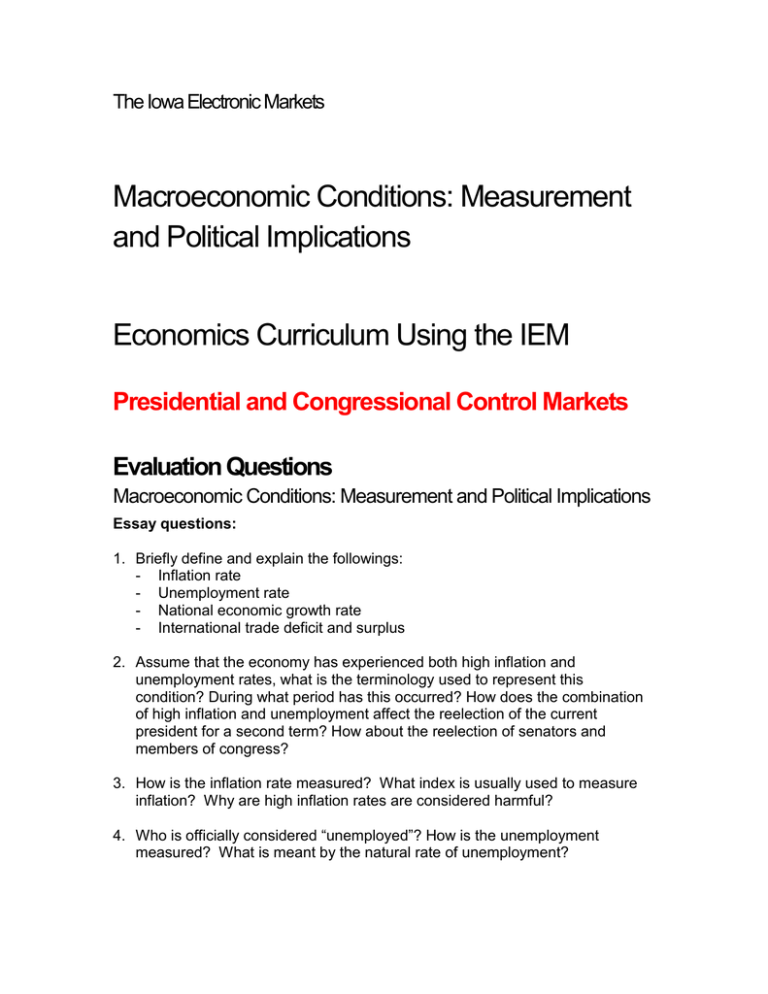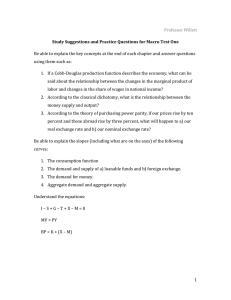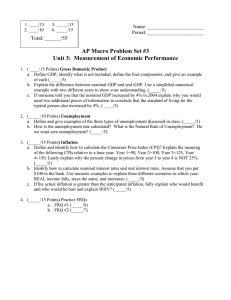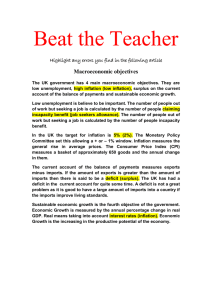Macroeconomic Conditions: Measurement and Political Implications Economics Curriculum Using the IEM
advertisement

The Iowa Electronic Markets Macroeconomic Conditions: Measurement and Political Implications Economics Curriculum Using the IEM Presidential and Congressional Control Markets Evaluation Questions Macroeconomic Conditions: Measurement and Political Implications Essay questions: 1. Briefly define and explain the followings: - Inflation rate - Unemployment rate - National economic growth rate - International trade deficit and surplus 2. Assume that the economy has experienced both high inflation and unemployment rates, what is the terminology used to represent this condition? During what period has this occurred? How does the combination of high inflation and unemployment affect the reelection of the current president for a second term? How about the reelection of senators and members of congress? 3. How is the inflation rate measured? What index is usually used to measure inflation? Why are high inflation rates are considered harmful? 4. Who is officially considered “unemployed”? How is the unemployment measured? What is meant by the natural rate of unemployment? 5. What is meant by the gross domestic production (GDP)? What is per capita GDP? Why is national economic growth measured by real per capita GDP? 6. Does the external economic relation of the nation (trade deficit/surplus and capital inflow and outflow) have any effect on the value of dollar in the foreign exchange market and on the economy as a whole? Is a continuous trade deficit combined with capital outflow an indication of change in economic condition or the overall productivity of the nation? 7. The Fair model is used as an example of economic models used for the prediction of an election. What are the general economic indicators used as variables in the Fair model? How does the model predict the election based on the economic conditions? 8. IEM political market has had a good record in predicting the national elections. The traders in IEM political market use their judgement about the economic conditions as well as the public opinion polls to guide their trades. Evaluate this statement. 9. What is the difference between consumer price index and the GDP deflator? Multiple Choice Questions: 1. The U.S. experienced highest inflation during the: a. 1960s b. 1970s c. 1980s d. 1990s 2. During the 1990s, a. inflation increased and unemployment increased too b. inflation decreased and unemployment increased c. inflation increased and unemployment decreased d. inflation decreased and unemployment decreased too 3. Consumer price index is a measure of a. costs and prices. b. cost of purchased goods by manufacturers. c. intermediate goods prices. d. change in the market value of a basket of goods and services that a typical urban person (household) consumes. 4. Unemployed is officially defined as a. a person 16 years old or older who is not employed and has tried to find work during the last four weeks as recorded by the employment office b. a person who is retired or not working c. a person who has not been working at least three months d. a person who has not worked six months or more in the year. 5. National debt is created by a. excessive consumer spending b. accumulated annual government budget deficits not offset by government budget surpluses c. excessive surplus and low deficit spending d. accumulated of debts in the business sector 6. An increase in trade deficit combined with net capital outflow causes the value of dollar to a. increase in the foreign exchange market b. decrease in the foreign exchange market c. change only if the government sets a new rate d. none of the above 7. The U.S. gross domestic product is a. the total market value of the all final goods and services produced by factors of production located in U.S. during a year b. the total market value of savings and investments c. total values of goods produced by U.S. citizens in U.S. and abroad d. total value of production in the 48 contiguous states in U.S. 8. The Fair model as discussed in relation to IEM political markets can be used for prediction of a. the fair share of government expenditure as a percentage of GNP b. fairness of income distribution c. the vote share of Democratic presidential candidates in a national election d. fair share of business in political contributions for election.








